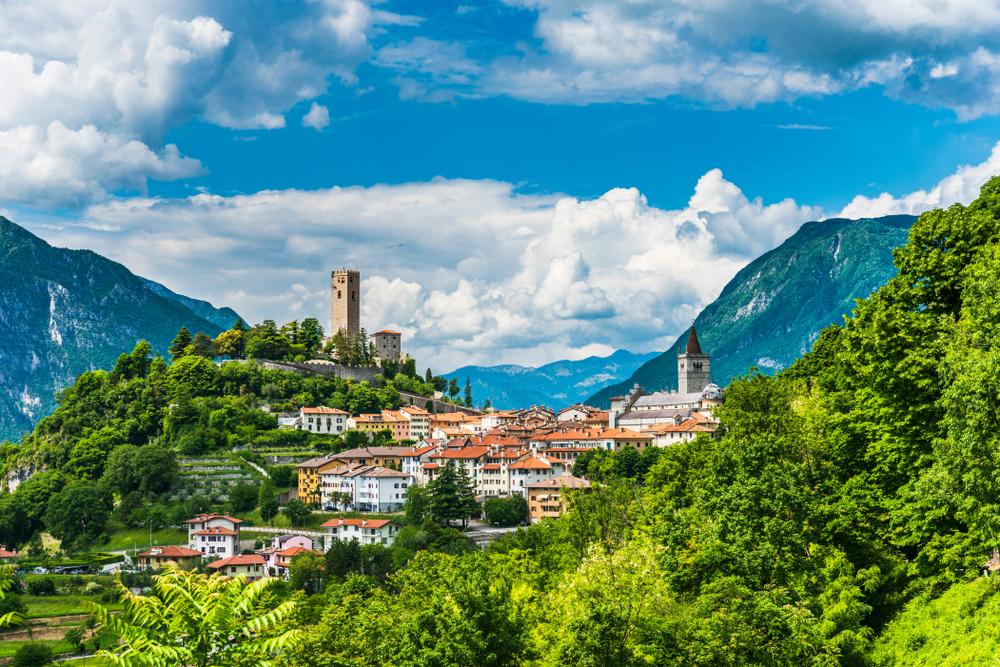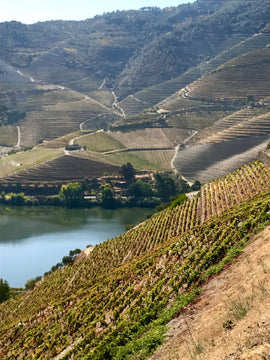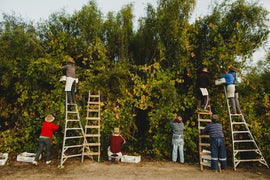Friuli - Venezia Giulia
Whenever I have the bad idea to generalize about Italian wine, I end up paraphrasing Humphrey Bogart in Casablanca - Italy is just like any other wine region, only more so. More grapes, more regions, more history, more passionate arguments conveyed with florid hand gestures. Impossible to pin down, sum up or exhaust, Italian wine presents such a vast and variegated world of its own that we have to narrow our focus just to make it manageable. So in Italian Wine Club we frame a different region each month, zooming in from there on all the smaller local traditions that comprise it. Sometimes in doing so we lose sight of the bigger picture - you know, the rest of the world.
While no wine region - even the actual islands - is a metaphorical island, there are some that have developed in relative isolation. Italy, with its long history of global engagement via trade, travel and conflict, is not one of them. The international influence on Italian viticulture has been profound, from the Germanic varietals of Alto Adige to the Mediterranean sweep of Sicily and Sardigna, to the mass cultivation of international grapes for the world market. Nowhere is this clearer than in Friuli - Venezia Giulia, the be-hyphened region occupying Italy’s far northwestern corner. Bordering Austria to north, Slovenia to the east, Veneto to the west and facing the Adriatic Sea to the south, Friuli - Venezia Giulia (henceforth abbreviated as Friuli) is the hinge that connects Italian peninsula with the Eastern Europe and Asia; since antiquity, it has been a highly contested crossroads of cultures, languages, religions and ethnicities. Most of the region was part of the Austro-Hungarian empire from the early 19th century until the end of the First World War in 1918, after which it was folded into Italy. Following World War II, the Istrian peninsula and the Carso plateau became part of Yugoslavia. The city of Trieste, historically one of Europe’s most important ports (and a great place to recall other places in exacting detail apparently - James Joyce completed Dubliners and Portrait of the Artist.. and began Ulysses whilst a resident) was declared a “Free Territory”, and divided into two zones to be administered by The United States-England and Yugoslavia, respectively. It did not become a part of Italy until 1954. The region as it is currently constructed only came into being in 1963.
Today, Friuli displays its complex provenance more proudly and easily than any time in recent history; Slavic and Germanic influences on the culture and cuisine co-exist with and complement the Italian and Mediterranean ones, local dialects are still spoken, and all of it gets reflected in the wine. Fruilian terroir is appropriately diverse, with the landscape characterized by coastal, flatlands, mountains and plateaus. There are 11 DOC and 3 DOCG’s in the region, with most of the vineyards located in the southern half, including the large wine regions of Collio Goriziano, Colli Orientali del Friuli, Isonzo, and the Slovenian border straddling Carso-Kras, one of the world’s only bi-national appellations. The white wines have historically overshadowed the reds (though this is changing somewhat) and there are over 30 different varietals under vine, from local specialities like Friulano, Ribolla Gialla, Picolit, Refosco, Schioppettino and Pignolo to a host of internationally famous grapes that receive distinctly Friulian renderings. This month we have two outstanding examples of the latter. The “white” is a Pinot Grigio (originally from France) made in the local Ramato style. The word comes from rame, copper in Italian, and is so named for the color of wine that results when the grape must macerates on its dark hued skins for an extended period. This is traditionally how all Pinot Grigio’s were produced in Italy until Santa Maghertia pioneered the now ubiquitous approach in 1960s. For the red, we have a Cabernet Franc, from a 100+ year-old winery in the village of Cormons di Brazzano, seven miles west of the Slovenian border. Both are farmed and made organically.
Jancis Robinson has referred to the wines of Friuli - Venezia Giulia as “in a way…foreign to Italians”. I think their cosmopolitan origins are a great opportunity to expand our conceptions of Italian wine - and make sure we don’t miss the proverbial vineyard for the vines. They are also unique and delicious. Hope you enjoy them!
Cheers,
Alan Hicks/Wine Buyer/Noe Valley
|
Region: Venezia Giulia IGT |
About the Winery: Stefano Novello grew up in the vineyards. Part of an old farmers’ family, his grandfather and uncles bought a rundown estate just after the Second World War with the desire to invest in the vineyards in Prepotto, a small village that sits by the Slovenian border in the province of Udine. Stefano’s philosophy is well represented by the label on his wine bottles: a kid in balance on the top rail of a chair. It means to be adventurous -- take challenges and risks when pursuing your dreams. Stefano is part of that movement called Vini Veri (True Wines). These are winemakers and viticulturists, mostly from this part of Italy, that approach wine making with an almost religious predisposition. The Association, born in 2004, requires the associate to follow strict rules: no herbicides or pesticides used in the vineyards, no GMO vines, only re-rooting from a pre-existent plant; no vitamins or other chemical ingredients in the cellar, only native yeasts, no filtration or clarification of the wines, and many other restrictions. This what classifies a natural wine, well beyond the organic concept. Those vignaioli (winegrowers) are searching for the best harmony between the land and man without compromises. What we get is a wine that does truly represent this legacy between the territory and who makes it. Stefano grows four white varietals (Pinot Grigio, Ribolla Gialla, Friulano and Picolit) and three reds (Refosco dal peduncolo rosso, Schioppettino and Merlot). The vineyards are on the hillside around 500ft above sea level on calcareous soil. About the Winemaking: Only the perfectly healthy and ripe grapes are hand picked late in harvest. The grapes are left to ferment on the skins in truncated cone shaped oak vats, without any temperature control, and without adding selected yeasts or enzymes. After soft pressing the wine remains on the lees for 23 months in 25-hl Slavonian oak barrels. The wine is then bottled without filtration on a waning moon between August and September. Fermentation on the skins results in the deep coppery yellow color typical of the varietal. Tasting Notes: The intense, pronounced bouquet is of acacia blossoms. Fruity when young, it develops back notes of dry hay, fresh walnuts and toasted almonds as it ages to reach notes reminiscent of cognac and armagnac. Aromatic notes of almonds and walnuts mingle with a floral edge backed up by crisp mineral notes in both the nose and mouth. This wine has a very tense edge with fine acidity which rounds out and opens up spectacularly with air, exposing a hugely complex aromatic profile. This is very serious wine. |
|
Winemakers: Stefano Novello |
|
|
Price per bottle / Price per case $35 $378 |
|
|
Suggested Food Pairing: Montasio cheese; grilled prawns; smoked trout; roasted chicken. |
|
|
Region Iszono di Friuli, Italy |
About the Winery: Simon di Brazzan (named for a villager named Simon who allegedly helped the widowed owner establish the estate in 1913) consists of about 13 hectares divided between the Collio and the Isonzo DOCs. Initially the estate was a typical farm with dairy cattle, pigs, other farm animals, plus vineyards. When Daniele Drius took over for his grandfather in 2006, he immediately banned the use of chemicals in the vineyards, introducing only natural practices. Eventually, he focused only on wine and expanded his vineyard holdings, and rather than sell the wine in bulk, started to bottle under the family label. For some years Daniele has been a fervid follower of biodynamic methods. Winemaker Natale Favretto joined Daniele 13 years ago adding his expertise of organic and biodynamic winemaking. About the Winemaking: Grown on .8 acres divided into two lots: Brazzano vineyard planted in 1985 and Mariano del Friuli vineyard planted in 1998. The soil is alluvial allochthonous with excellent drainage and good fertility; sufficient rainfall appropriate to vine growing grass between alternate rows. Bunch cutting occurs, according to the season, to maintain a consistent yield for vine. Old leaves near the grape bunches are removed to keep the grapes healthy and complete ripening. Harvested manually from September to mid-October. Vinification is traditional, starting with careful de-stemming; followed by a heat exchanger to cool the de-stemmed grapes. Light maceration of the skins in the press. Then soft pressing. The must is cleaned using the cold settling method. Temperature-controlled fermentation. The wine left in contact with lees for a long period. Tasting Notes: An intense ruby red color with purple hues. Its characteristic herbaceous fragrance is elegant and spicy. On the palate the wine is velvety, smooth. It will continue to develop over the next few years. |
|
Winemaker: Daniele Drius & Natale Favretto |
|
|
Price per bottle / Price per case $27 $259.2 |
|
|
Suggested Food Pairing: gamey meats such as lamb, rabbit, duck and venison.It also pairs nicely with hearty fish dishes, and even hard as well as soft cheeses. |
|
CINNAMON SPICED PORK RAGU WITH TAGLIATELLE.
A specifically Friulian pasta - no garlic or olive oil, but the cinnamon is indicative of Trieste’s history as a spice trading destination.
INGREDIENTS
- 400 g tagliatelle (14 oz) You can also use pasta tubes or other pasta ribbons
- 400 g pork tenderloin (14 oz) or shoulder
- 1 onion peeled and finely chopped
- 30 g butter (1oz)
- 1 bunch herbs (marjoram, rosemary, thyme, sage, bay leaf)
- 1/2 glass white wine
- 2 eggs
- 45 g Montasio or Parmigiano grated
- salt for pasta and to taste
- black pepper to taste
- 1 tsp cinnamon powder
- 2-3 cloves or 1 tsp clove powder
- Cut the meat into small pieces and brown it in melted butter in a deep frying pan or iron skillet.
- Stir, then lower the heat, add salt, pepper, cloves and cinnamon. Pour in the wine and continue cooking.
- Peel and finely chop the onion. Wash and chop the herbs (if fresh) except the bay leaf.
- Reduce some of the liquid over a moderate heat, then add the finely chopped onion and the bunch of aromatic herbs, cover and cook, slowly and for about 45 minutes to one hour.
- Put a pot of water onto boil for the pasta. Add salt once it starts to boil and bring to the boil again. Cook the pasta al dente according to the instructions on the packet.
- Break the eggs into a bowl and beat with a pinch of salt.
- Drain the pasta and add it to the pan with the meat sauce, mix together well . Add the beaten egg a little at a time whilst stirring continuously until all the pasta is coated with the eggs and sauce.
- Serve immediately with the grated cheese.





